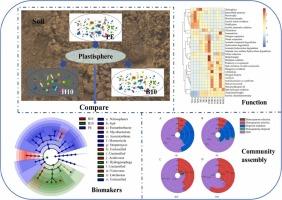Comparison of plastisphere microbiomes during the degradation of conventional and biodegradable mulching films
IF 12.2
1区 环境科学与生态学
Q1 ENGINEERING, ENVIRONMENTAL
引用次数: 0
Abstract
Biodegradable mulch films (BDMs) are becoming increasingly popular in agriculture and are emerging as an alternative to conventional polyethylene (PE) films. However, the intricate details surrounding the establishment and growth of BDMs and PE during their degradation in agricultural fields remain unclear. In this study, the succession of bacterial communities in farmland soil and the plastispheres of PE and BDMs were compared through 16S rRNA gene high-throughput sequencing and Real-time PCR. The results unveiled noteworthy distinctions in bacterial community structures across different samples. Specifically, the α-diversity in the BDM plastispheres was markedly lower than in the PE plastisphere. Hydrogenophaga and Variovorax genera were abundantly present in the BDM plastisphere, whereas Mycobacterium demonstrated significant enrichment in the PE plastisphere. Functional annotations indicated high abundances of degradation-related and pathogen-related functions in both BDM and PE plastispheres. Furthermore, the BDM plastisphere exhibited lower network complexity and modularity and stronger competitive interactions than the PE plastisphere. The iCAMP analysis showed that stochastic community assembly processes largely govern the PE plastisphere, while deterministic processes prevailed in BDMs and increased significantly over time. These findings shed light on different mulching materials’ effects in farmland ecosystems and provide insights into potential ecological risks linked to their usage.

常规地膜与可生物降解地膜降解过程中塑料球微生物群的比较
生物可降解地膜(bdm)在农业中越来越受欢迎,并正在成为传统聚乙烯(PE)薄膜的替代品。然而,围绕bdm和PE在农田降解过程中建立和生长的复杂细节仍不清楚。本研究通过16S rRNA基因高通量测序和Real-time PCR,比较了农田土壤细菌群落演替以及PE和bdm的塑性球。结果揭示了不同样品中细菌群落结构的显著差异。其中,BDM塑料球中α-多样性明显低于PE塑料球。嗜氢菌属和变异菌属在BDM塑料球中大量存在,而分枝杆菌属在PE塑料球中富集。功能注释表明,BDM和PE塑料球中具有高丰度的降解相关和病原体相关功能。此外,BDM塑性圈比PE塑性圈表现出更低的网络复杂性和模块化,以及更强的竞争相互作用。iCAMP分析表明,随机群落组装过程在很大程度上控制着PE塑性球,而确定性过程在bdm中占主导地位,并随着时间的推移而显著增加。这些发现揭示了不同覆盖材料对农田生态系统的影响,并提供了与它们的使用相关的潜在生态风险的见解。
本文章由计算机程序翻译,如有差异,请以英文原文为准。
求助全文
约1分钟内获得全文
求助全文
来源期刊

Journal of Hazardous Materials
工程技术-工程:环境
CiteScore
25.40
自引率
5.90%
发文量
3059
审稿时长
58 days
期刊介绍:
The Journal of Hazardous Materials serves as a global platform for promoting cutting-edge research in the field of Environmental Science and Engineering. Our publication features a wide range of articles, including full-length research papers, review articles, and perspectives, with the aim of enhancing our understanding of the dangers and risks associated with various materials concerning public health and the environment. It is important to note that the term "environmental contaminants" refers specifically to substances that pose hazardous effects through contamination, while excluding those that do not have such impacts on the environment or human health. Moreover, we emphasize the distinction between wastes and hazardous materials in order to provide further clarity on the scope of the journal. We have a keen interest in exploring specific compounds and microbial agents that have adverse effects on the environment.
 求助内容:
求助内容: 应助结果提醒方式:
应助结果提醒方式:


